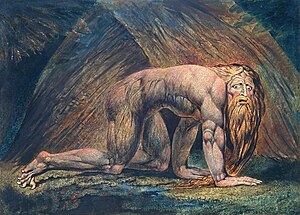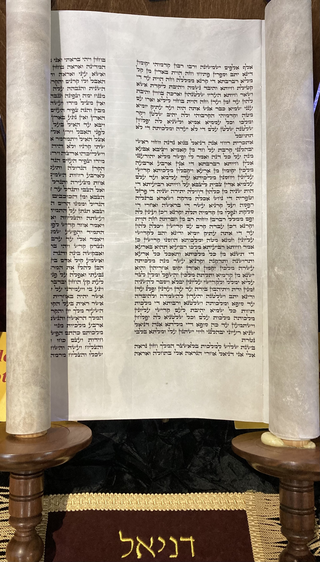
The Book of Daniel is a biblical apocalypse authored during the 2nd century BC, and set during the 6th century BC. The work describes "the activities and visions of Daniel, a noble Jew exiled at Babylon"; in doing so, it interpolates a portrayal of a historical prophecy being fulfilled with a prediction of future cosmic and political upheaval. This eschatology ultimately affirms that the God of Israel's previous deliverance of Daniel from his enemies prefigures his future deliverance of the people of Israel from their present oppression.
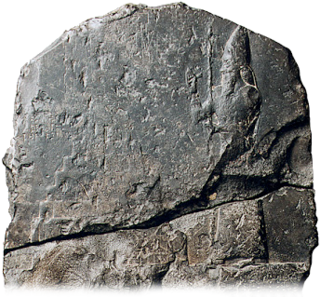
Nebuchadnezzar II, also spelled Nebuchadrezzar II, was the second king of the Neo-Babylonian Empire, ruling from the death of his father Nabopolassar in 605 BC to his own death in 562 BC. Historically known as Nebuchadnezzar the Great, he is typically regarded as the empire's greatest king. Nebuchadnezzar remains famous for his military campaigns in the Levant, for his construction projects in his capital, Babylon, including the Hanging Gardens of Babylon, and for the role he plays in Jewish history. Ruling for 43 years, Nebuchadnezzar was the longest-reigning king of the Babylonian dynasty. By the time of his death, he was among the most powerful rulers in the world.

Apocalypse is a literary genre in which a supernatural being reveals cosmic mysteries or the future to a human intermediary. The means of mediation include dreams, visions and heavenly journeys, and they typically feature symbolic imagery drawn from the Hebrew Bible, cosmological and (pessimistic) historical surveys, the division of time into periods, esoteric numerology, and claims of ecstasy and inspiration. Almost all are written under pseudonyms, claiming as author a venerated hero from previous centuries, as with the Book of Daniel, composed during the 2nd century BC but bearing the name of the legendary Daniel.

Belshazzar was the son and crown prince of Nabonidus, the last king of the Neo-Babylonian Empire. Through his mother, he might have been a grandson of Nebuchadnezzar II, though this is not certain and the claims to kinship with Nebuchadnezzar may have originated from royal propaganda.
The oldest surviving Hebrew Bible manuscripts, the Dead Sea Scrolls, date to c. the 2nd century BCE. Some of these scrolls are presently stored at the Shrine of the Book in Jerusalem. The oldest text of the entire Bible, including the New Testament, is the Codex Sinaiticus dating from the 4th century CE, with its Old Testament a copy of a Greek translation known as the Septuagint. The oldest extant manuscripts of the vocalized Masoretic Text date to the 9th century CE. With the exception of a few biblical sections in the Nevi'im, virtually no biblical text is contemporaneous with the events it describes.

Belshazzar's feast, or the story of the writing on the wall, chapter 5 in the Book of Daniel, tells how Belshazzar holds a great feast and drinks from the vessels that had been looted in the destruction of the First Temple. A hand appears and writes on the wall. The terrified Belshazzar calls for his wise men, but they are unable to read the writing. The queen advises him to send for Daniel, renowned for his wisdom. Daniel reminds Belshazzar that his father Nebuchadnezzar, when he became arrogant, was thrown down until he learned that God has sovereignty over the kingdom of men. Belshazzar had likewise blasphemed God, and so God sent this hand. Daniel then reads the message and interprets it: God has numbered Belshazzar's days, he has been weighed and found wanting, and his kingdom will be given to the Medes and the Persians.
That very night Belshazzar, the Chaldean [Babylonian] king, was killed. And Darius the Mede received the kingdom […]
The Prophecy of Seventy Weeks is the narrative in chapter 9 of the Book of Daniel in which Daniel prays to God to act on behalf of his people and city, and receives a detailed but cryptic prophecy of "seventy weeks" by the angel Gabriel. The prophecy has been the subject of "intense exegetical activity" since the Second Temple period. James Alan Montgomery referred to the history of this prophecy's interpretation as the "dismal swamp" of critical exegesis.

"Abomination of desolation" is a phrase from the Book of Daniel describing the pagan sacrifices with which the 2nd century BC Greek king Antiochus IV Epiphanes replaced the twice-daily offering in the Jewish temple, or alternatively the altar on which such offerings were made.

Darius the Mede is mentioned in the Book of Daniel as King of Babylon between Belshazzar and Cyrus the Great, but he is not known to secular history and there is no space in the historical timeline between those two verified kings.
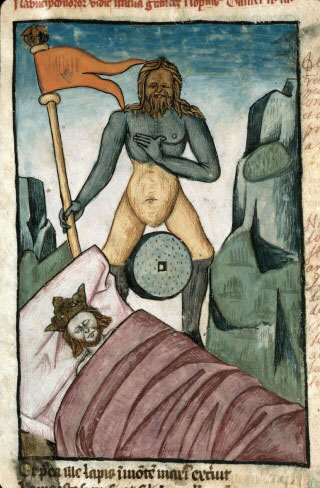
Daniel 2 tells how Daniel related and interpreted a dream of Nebuchadnezzar II, king of Babylon. In his night dream, the king saw a gigantic statue made of four metals, from its head of gold to its feet of mingled iron and clay; as he watched, a stone "not cut by human hands" destroyed the statue and became a mountain filling the whole world. Daniel explained to the king that the statue represented four successive kingdoms beginning with Babylon, while the stone and mountain signified a kingdom established by God which would never be destroyed nor given to another people. Nebuchadnezzar then acknowledges the supremacy of Daniel's God and raises him to high office in Babylon.
Daniel 7 tells of Daniel's vision of four world-kingdoms replaced by the kingdom of the saints or "holy ones" of the Most High, which will endure for ever. Four beasts come out of the sea, the Ancient of Days sits in judgment over them, and "one like a son of man" is given eternal kingship. An angelic guide interprets the beasts as kingdoms and kings, the last of whom will make war on the "holy ones" of God, but they will be destroyed and the "holy ones" will be given eternal dominion and power.
Daniel 8 is the eighth chapter of the Book of Daniel. It tells of Daniel's vision of a two-horned ram destroyed by a one-horned goat, followed by the history of the "little horn", which is Daniel's code-word for the Greek king Antiochus IV Epiphanes.

Shadrach, Meshach, and Abednego are figures from chapter 3 of the biblical Book of Daniel. In the narrative, the three Jewish men are thrown into a fiery furnace by Nebuchadnezzar II, King of Babylon for refusing to bow to the king's image. The three are preserved from harm and the king sees four men walking in the flames, "the fourth ... like a son of God". They are first mentioned in Daniel 1, where alongside Daniel they are brought to Babylon to study Chaldean language and literature with a view to serving at the King's court, and their Hebrew names are replaced with Chaldean or Babylonian names.

The four kingdoms of Daniel are four kingdoms which, according to the Book of Daniel, precede the "end-times" and the "Kingdom of God".
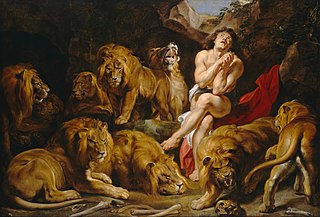
Daniel is the main character of the Book of Daniel. According to the Hebrew Bible, Daniel was a noble Jewish youth of Jerusalem taken into captivity by Nebuchadnezzar II of Babylon, serving the king and his successors with loyalty and ability until the time of the Persian conqueror Cyrus, all the while remaining true to the God of Israel. While some conservative scholars hold that Daniel existed and his book was written in the 6th century BCE, most scholars agree that Daniel is not a historical figure and that much of the book is a cryptic allusion to the reign of the 2nd century BCE Hellenistic king Antiochus IV Epiphanes.
Chapters 10, 11, and 12 in the Book of Daniel make up Daniel's final vision, describing a series of conflicts between the unnamed "King of the North" and "King of the South" leading to the "time of the end", when Israel will be vindicated and the dead raised, some to everlasting life and some to shame and everlasting contempt.

Daniel in the lions' den tells of how the biblical Daniel is saved from lions by the God of Israel "because I was found blameless before him". It parallels and complements chapter 3, the story of Shadrach, Meshach, and Abednego: each begins with the jealousy of non-Jews towards successful Jews and an imperial edict requiring them to compromise their religion, and concludes with divine deliverance and a king who confesses the greatness of the God of the Jews and issues an edict of royal protection. The tales making up chapters 1–6 of Daniel date no earlier than the Hellenistic period and were probably originally independent, but were collected in the mid-2nd century BC and expanded shortly afterwards with the visions of the later chapters to produce the modern book.
The concept of kingship of God appears in the Hebrew Bible with references to "his Kingdom" and "your Kingdom" while the term "kingdom of God" is not directly used. "Yours is the kingdom, O Lord" is used in 1Chronicles 29:10–12 and "His kingdom is an everlasting kingdom" in Daniel 4:3, for example. It is tied to Jewish understanding that through the messiah, God will restore the Kingdom of Israel, following the Davidic covenant.

Daniel 1 tells how Daniel and his three companions were among captives taken by Nebuchadnezzar II from Jerusalem to Babylon to be trained in Babylonian wisdom. There they refused to take food and wine from the king and were given knowledge and insight into dreams and visions by God, and at the end of their training they proved ten times better than all the magicians and enchanters in the kingdom.

Ezra 1 is the first chapter of the Book of Ezra in the Old Testament of the Christian Bible, or the book of Ezra–Nehemiah in the Hebrew Bible, which treats the book of Ezra and book of Nehemiah as one book. Jewish tradition states that Ezra is the author of Ezra–Nehemiah as well as the Book of Chronicles, but modern scholars generally believe that a compiler from the 5th century BCE is the final author of these books.
